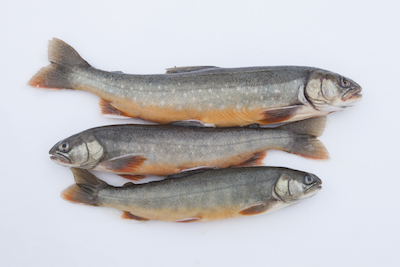Arctic Charr Distribution

As you may have guessed from the numerous names for this fish, the Arctic Charr is not only the most northerly ranging freshwater fish game fish, it’s also circumpolar in its distribution.
The Arctic Charr is found in landlocked rivers and lakes as well as in the ocean from the across northern Canada, Alaska, the Aleutian Islands across northern Russia’s Arctic, south to Lake Baikal.
It’s also found in the waters of Iceland, Great Britain and Scandinavia.
In the United States and Canada the Arctic Charr can be found from Alaska around the Bering Sea and along the Arctic coast to Baffin Island in the Canadian Arctic. Included is the watershed of Hudson’s Bay, northern Quebec, Labroador, Newfoundland and along the northern coast of the United States including Maine and New Hampshire.
The Arctic Charr can be found inland, but prefers the ocean habitat. However, due to geological changes and recent ice ages, Arctic Charr have been found locked in lakes and rivers in the Northwest Territories and Nunavut Territory, never reaching the sea.
Human Impact
Despite being located in and close to the Arctic, increased development and over fishing have reduced the stocks of Arctic Charr in many locations, as well as reducing the average size.
Cold climates reduce the speed of growth of all animal and plant life. Arctic Charr are no different.
As with all species, the largest fish are the first to go followed by a population of smaller and smaller fish being present. The result is even smaller average sizes of Arctic Charr.
This species has few enemies. Only the young are vulnerable so the reduced population is definitely the result of human over fishing and development. In areas under pressure, consider the practice of catch and release.
Although they’re sold in many stores and fish markets, these are usually farmed fish and coming from their native range.
Arctic Conditions
The Arctic is often considered as another world. The Arctic lacks any trees and the ground is frozen all year round with the exception of a few inches of warming on the surface which creates muddy and slippery conditions. Bring appropriate footwear that is water proof and can be worn down to 14°F/-10°C.
From the Arctic circle north, the sun never sets for at least one day in the summer, with the high Arctic offering months of daylight. Below the arctic circle, nights may only last a few hours if at all. However, despite the endless summer days, temperatures are anything but predictable.
While the temperature can reach 86°F/30°C, they can also plummet to -10°C/14°F along with heavy blowing snow. We recommend taking along a wide range of breathable clothing and carry bags that are waterproof. Retail stores, outfitters and medical services are often hundreds if not thousands of miles away so be well stocked and prepared.
Guides & Safety Equipment
The Arctic is unforgiving. Many great fishing locales are over a 1000 miles/1600 km from a hospital. Bring along an emergency medical kit, extra batteries, plenty of warm and water proof gear. A satellite phone is a must.
Be sure to hire a guide if you’re fishing in a location where you’re unfamiliar. A guide can make the difference between having a great vacation and not returning.


